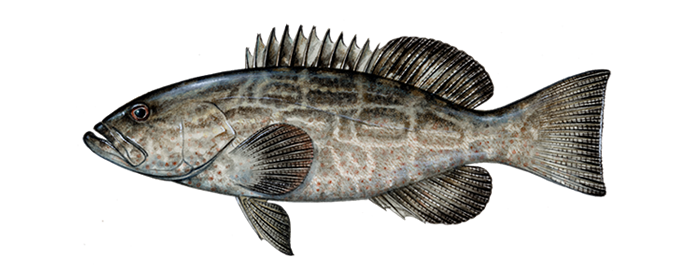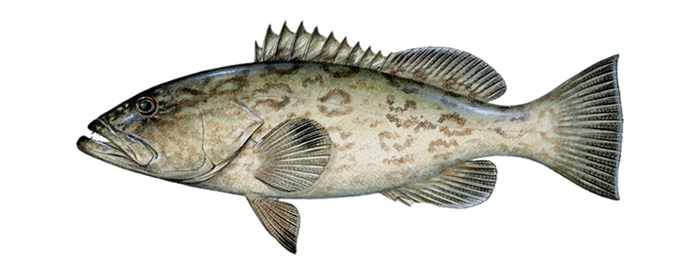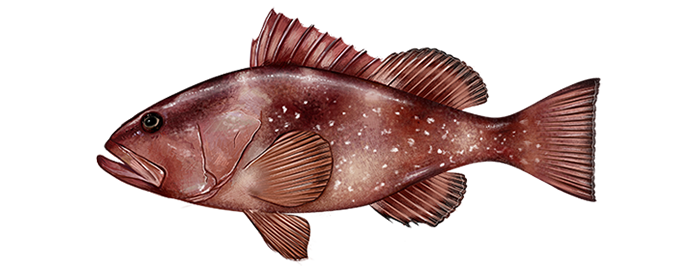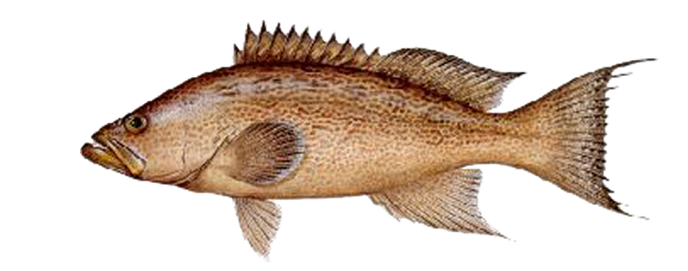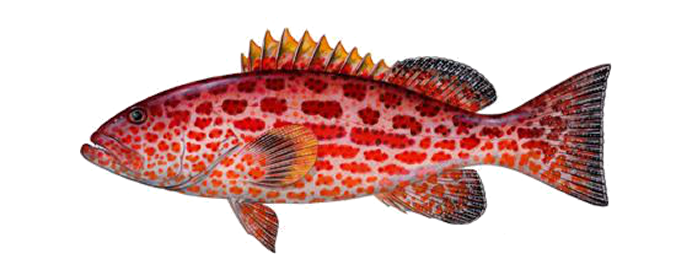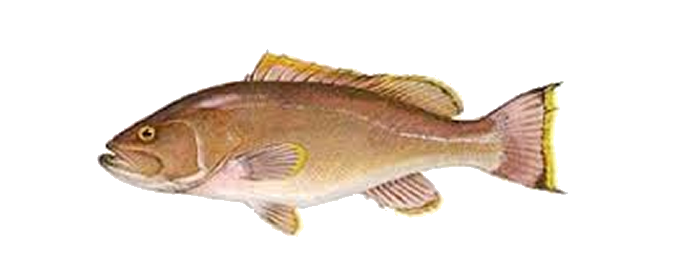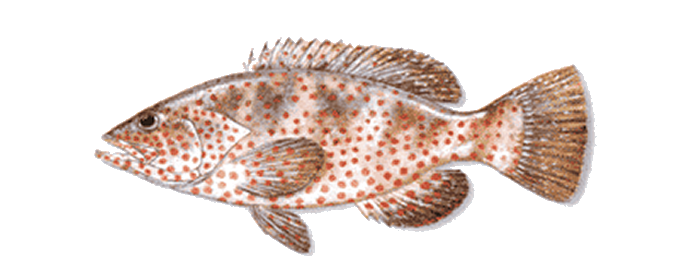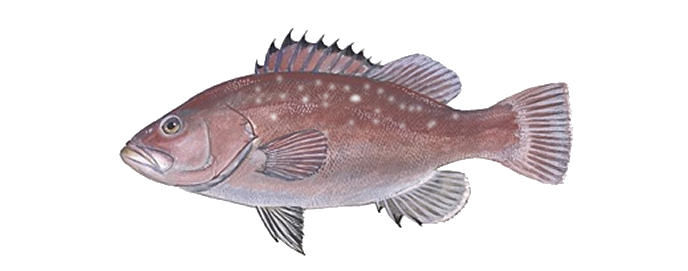There are many different types of Grouper available to catch in Florida. They are one of the tastiest fish and are usually found around reefs and structures and multiple depths. The best bait to catch grouper is a live pinfish, cigar minnow, small crabs or even small snappers. Live ballyhoo, pilchard or Spanish sardines also work well. If you don’t have live bait they will also go after jigs or dead bait. A good selection of dead bait for grouper is sardines, mullet, ballyhoo, mackerel or pinfish. The larger ones like the jewfish(Goliath Grouper) require heavier tackle because this fish can get massive. Below are the most popular types of Grouper you can catch in Miami and the surrounding areas. Select one of the fishes below to get more information on the different species.
Black Grouper
Black groupers feed mostly on small fish and squid. They are large fish and can be found on rocky bottoms, reefs, and drop off walls in water over 60 feet deep.
Gag Grouper
One of the best tasting groupers you can catch. They are found on shallow reefs throughout Florida and usually weigh around 25 pounds. The larger ones have black or copper colored bellies and are often referred to as black bellies or copper bellies.
Goliath Grouper
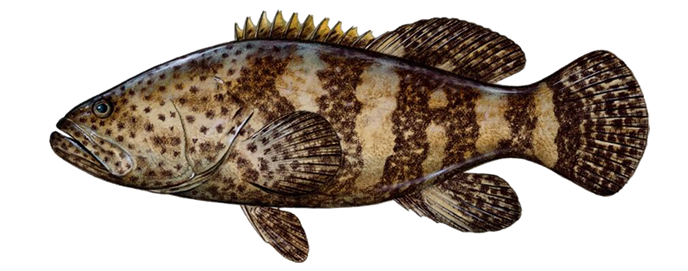
The Goliath Grouper is an endangered species that can weigh up to 800 pounds and grow up to 8 feet in leangth. They can be found on artificial and natural reefs at depths anywhere from 15 to 165 feet. This is a large Grouper weighing up to 800 pounds and can grow to 8 feet in length. Many anglers catch this giant while fishing for other species. The Goliath is known for stealing anglers catches as they reel them in. The Goliath feed on mostly slow-moving creatures, rarely do they target large fish as the Goliath is a very lethargic species that spends most of its time hiding out in caves waiting to ambush its next meal.
Nassau Grouper
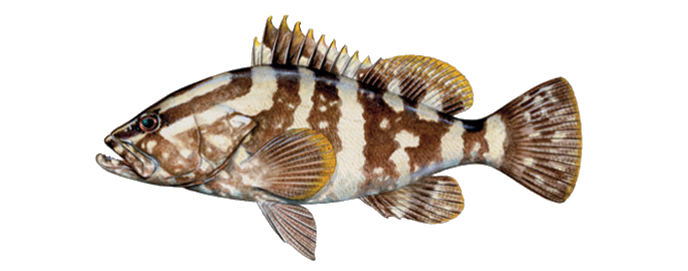
The Nassau Grouper can be found in waters around 60 feet near coral reefs and structure, but has been found inshore and offshore in 300 feet. The species has been over fished and in 2016 was classified as “threatened”. The Nassau Grouper is a slow-growing species reaching a little over 3 feet in length and can weight 55 pounds. It is a solitary fish, feeding in the daytime, mainly on other fish, and small crustaceans like crabs and small lobsters. This fish is very friendly and will swim right up to divers. You can tell a Nassau Grouper from a Red Grouper because a Nassau Grouper has a black saddle on the base of the tail. Unfortunately the man holding the Nassau above has a hand on the tail, hiding the black saddle. If you look close and you can see it.
Red Grouper
Red Grouper like to hide in a hole and dart out to grab food and return to their hole. Due to this habit of darting out for food, they are opportunistic and will eat most anything. They prefer squid, crab, shrimp, lobster and octopus, but will eat any dead fish that sink into their habitat. Chumming with a weighted dispenser close to structure then dropping your line with bait into the chum slick works well for this species.
Scamp
The Scamp is commonly 10 to 20 pounds and is sometimes found fairly close to shore, but generally sticks to deep reefs and ledges offshore. The Scamp’s spots can sometimes form close together creating larger spot-like area’s. The Scamp is plentiful in the Gulf of Mexico and can be found in the Atlantic mostly on the northern Florida coast. This Grouper is considered a prized catch among Groupers.
Warsaw Grouper
The Warsaw Grouper is a large fish growing to 6 feet (1.8 m) and can weigh over 550 pounds (263 kg). Find the Warsaw near deep rocky ledges and sea mounts in 300 to 1000 feet (90-300 m) of water; the young are sometimes caught in inshore waters.
Beginning January 31, 2011 it is prohibition to harvest or retain the Speckled Hind and Warsaw Grouper in federal waters in the South Atlantic.
Yellowfin Grouper
The beautiful Yellowfin Grouper is more commonly found in the warmer waters of the southern part of Florida on offshore coral reefs, wrecks and hard drop-offs.
The Yellowfin Grouper grows to 30 pounds and 4 feet long with the record of 34 pounds 6 ounces caught near Key Largo. Standard bottom fishing setup can be used to catch the Yellowfin with live bait or shrimp.
Yellowmouth Grouper
The Yellowmouth Grouper is a reef dweller that is very abundant in the Gulf of Mexico. The Yellowmouth is often confused with the Scamp and shares the same waters as the Scamp, but the Yellowmouth has a square tail. This fish pounces on jigs readily.
Yellowedge Grouper
The Yellowedge Grouper has been abundant in the Gulf of Mexico caught in deep offshore waters from 160 feet to almost 1,000 feet. Small live and cut baits can be used to catch this Grouper. This Grouper can grow to 30 pounds and tend to be smaller in the eastern Gulf of Mexico due to the lack of soft bottom. In the eastern Gulf the Yellowedge Grouper is most prevalent from Tampa to Charlotte in 600 feet of water near patch reefs with soft bottom areas where the Yellowedge can burrow in the soft sand
Tiger Grouper
The Tiger Grouper can be seen during the day prowling around shallow coral reefs from 5 to 20 feet looking for prey. This grouper has vertical stripes and sometimes a redish color; juveniles are yellowish. The Tiger reaches around 8-10 pounds, 35 inches long, and feeds on small fish, squid, shrimp, and crabs, devouring them with it’s big teeth.
Red hind
The Red Hind are found on shallow reefs and feed on crabs, shrimp, lobster, some fish and octopus.
Rock hind
Wahoo is another fun fighting marine game fish you can catch in Miami. The Wahoo is a highly prized game fish due to its aggressive fighting style and tasty meat. These fish are best caught using high speed trolling rigs. For more information on Wahoo including bag limit and fishing techniques visit our Wahoo section.
Marbled Grouper
The Marbled Grouper is classified as vulnerable by the American Fisheries Society and is rarely caught but can be found in most tropical waters. It is the different looking of the groupers with a heavy body and it’s ability to change color. This rare fish is commonly caught at 15 pounds as an incidental catch while bottom fishing deeper reefs.
Snowy Grouper
The Snowy Grouper is a mean one due to it’s territorial nature. The Snowy can be caught inshore (usually the youngsters) but it is primarily found on the Atlantic continental shelf in deep water, 300 to 500 feet, along rocky edges and cliffs in swift currents. The Snowy Grouper can reach 70 pounds and 52 inches long. This species is in serious decline due to overfishing so the restrictions are 1 Snowy per person per day (always check current rules). The Snowy feeds on blue crab, fish, and squid.
Misty Grouper
The most ferocious predators in the sea, Sharks are a fun aggressive fish to catch. There are several types of sharks including hammerhead, black tip, and mako sharks are the most popular.
Coney
Coney Grouper is a smaller fish that can be found with several different color combinations from, yellow, brown, orange and even white with a red head. Most of them have little spots all over thier body. They can change colors to match their environment if they feel threatened. They are usually found in the warm waters of southern Florida, mostly the Atlantic coast, usually hiding in holes on coral reefs waiting to ambush its prey.
Graysby
The Graysby likes to hide in holes and ambush it’s prey. The Graysby grows to 15 pounds and is usually not targeted but an accidental catch.
Black Sea Bass
The most ferocious predators in the sea, Sharks are a fun aggressive fish to catch. There are several types of sharks including hammerhead, black tip, and mako sharks are the most popular.


